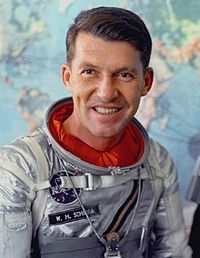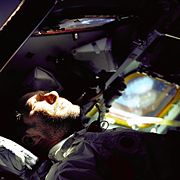Wally Schirra
| Walter Schirra | |
 |
|
| NASA Astronaut | |
|---|---|
| Born | March 12, 1923 |
| Died | May 3, 2007 (aged 84) |
| Other occupation | Test Pilot |
| Rank | Captain, USN |
| Time in space | 12d 7h 12m |
| Selection | 1959 NASA Group |
| Missions | Mercury 8, Gemini 6A, Apollo 7 |
| Mission insignia |
|
Walter Marty Schirra, Jr. (March 12, 1923 – May 3, 2007) was one of the original Mercury 7 astronauts chosen for the Project Mercury, America's first effort to put men in space. He was the only man to fly in all of America's first three space programs (Mercury, Gemini and Apollo). He logged a total of 295 hours and 15 minutes in space.
Contents |
Biography
Schirra was born into an aviation family in Hackensack, New Jersey. Schirra's father, Walter M. Schirra, Sr., went to Canada during World War I and earned his pilot rating. He later became a barnstormer. Schirra's mother, Florence Leach Schirra, went along on her husband's barnstorming tours and performed wing walking stunts. By the time he was 15, Wally was flying his father's airplane. Schirra was a Boy Scout and earned the rank of First Class in Troop 36 in Oradell, New Jersey.[1]
Schirra graduated from Dwight Morrow High School in Englewood, New Jersey and attended the New Jersey Institute of Technology in 1941, where he was a member of Sigma Pi Fraternity. He later finished schooling with the navy and received a Bachelor of Science in aeronautical engineering.

He attended the United States Naval Academy and graduated in 1945. He was commissioned as an officer in the United States Navy, serving the final months of World War II aboard the battle cruiser USS Alaska. After the war ended, he trained as a pilot at NAS Pensacola and joined a carrier fighter squadron. He became only the second naval aviator to log 1,000 hours in jet aircraft.
Upon the outbreak of the Korean War, Schirra was dispatched to South Korea as an exchange pilot on loan to the US Air Force. He served as a flight leader with the 136th Bomb Wing, and then as operations officer with the 154th Fighter Bomber Squadron. He flew 90 combat missions between 1951 and 1952, mostly in F-84s. Schirra was credited with downing one MiG-15 and damaging two others. Schirra received the Distinguished Flying Cross and the Air Medal with an oak leaf cluster for his service in Korea.
After his tour in Korea, Schirra served as a test pilot. At China Lake he tested weapons systems such as the Sidewinder missile and the F7U-3 Cutlass jet fighter. After spending time as a flight instructor and carrier based aviator, he later returned to his test pilot duties and helped evaluate the F-4 fighter for naval service. In the image at left, Schirra is shown taking delivery of a F3H Demon from McDonnell Design Chief, Dave Lewis. They remained good friends, later working together on the McDonnell Mercury 7 program.
NASA experience

On April 2, 1959, Schirra was chosen as one of the original seven American astronauts. He entered Project Mercury and was assigned the specialty area involving life support systems.
Mercury
On October 3, 1962, Schirra became the fifth American in space, piloting the Mercury-Atlas 8 (Sigma 7) on a six-orbit mission lasting 9 hours, 13 minutes, and 11 seconds. The capsule attained a velocity of 17,557 miles per hour and an altitude of 175 statute miles, and landed within four miles of the main Pacific Ocean recovery ship.
Gemini
On December 15, 1965, Schirra flew into space a second time in Gemini 6A with Tom Stafford. During the first launch attempt, the booster rocket unexpectedly shut down seconds after ignition. Although mission rules called for the crew to eject from the spacecraft in that situation, Schirra used his pilot's judgement and did not eject, which turned out to be the correct call. The flight launched successfully the next day, conducting the first manned space rendezvous with astronauts Frank Borman and James Lovell, Jr. in Gemini 7. The two vehicles, however, were not capable of actually docking. Gemini 6 landed in the Atlantic Ocean the next day, while Gemini 7 continued on to a record-setting 14-day mission. While on the Gemini mission, Schirra attracted notoriety for playing "Jingle Bells" on a four-hole Hohner harmonica he had smuggled on board, and a "Wally Schirra" commemorative model was later produced.
Apollo

On October 11, 1968, Schirra became the first person to fly in space three times on his final flight as commander of Apollo 7, the first manned flight in the Apollo program, which occurred after a fatal fire during tests of Apollo 1. The three-person crew, including Donn Eisele and Walter Cunningham, spent eleven days in earth orbit, performed rendezvous exercises with the upper stage of the Saturn 1-B launch vehicle that rocketed them into space and provided the first live television pictures from inside a U.S. manned spacecraft (other than an experimental broadcast during the flight of Gordon Cooper) for which he received an Emmy.
During the Apollo 7 mission, Schirra caught what was perhaps the most famous cold in NASA history.[1] He took Actifed to relieve his symptoms upon the advice of the flight surgeon. Schirra soon passed the cold to Eisele, and the crew became known for their grumpy exchanges with Houston. Interaction with ground controllers became so strained that the crew was taken out of rotation for future missions, and none of the three flew for NASA again. Schirra had made the decision to retire before launch, and left the astronaut corps after the mission. Years later, he became a spokesman for Actifed and would appear in television commercials advertising the product.[2]
During later Apollo missions he served as a news consultant, often being interviewed by Walter Cronkite on CBS News. He co-anchored with Cronkite and Arthur C. Clarke the first Apollo landing on the Moon. [3]
Schirra's logbooks show a total of 4,577 hours flight time (295 in space) and 267 carrier landings.
In 2008, NASA posthumously awarded Schirra the NASA Distinguished Service Medal for his Apollo 7 mission.[4]
Writing career
In 2005 Schirra co-authored the book The Real Space Cowboys with Ed Buckbee. The book is an account of the 'Mercury Seven' astronauts. It follows them through the process of selection for the program, their entire careers, and into retirement. Also, Wernher von Braun, NASA, Space Camp, and the U.S. Space and Rocket Center are given special attention.
Schirra was also a major contributor to the 2007 book In the Shadow of the Moon , which captured his final published thoughts on his life and career.
Death
He died on May 3, 2007 of a heart attack due to malignant mesothelioma at Scripps Green Hospital in La Jolla, California.[5][6] A memorial service for Schirra was held on May 22 at Fort Rosecrans National Cemetery in California. The ceremony concluded with a 21-gun salute and a flyover by three F-18s. Schirra was cremated and his ashes were committed to the sea on February 11, 2008. The burial-at-sea ceremony was held aboard the Nimitz-class aircraft carrier USS Ronald Reagan (CVN 76) and his ashes were released by Cmdr. Lee Axtell, command chaplain aboard.[7][8]
The planned Lewis and Clark class dry cargo ship USNS Wally Schirra (T-AKE-8) will be named for Schirra.[9]
Schirra on screen
Wally Schirra was portrayed by Lance Henriksen in the film The Right Stuff and by Mark Harmon in the miniseries From the Earth to the Moon.
Definition of a space rendezvous
Schirra stated a clear definition of a space rendezvous. He said:
"Somebody said ... when you come to within three miles, you've rendezvoused. If anybody thinks they've pulled a rendezvous off at three miles, have fun! This is when we started doing our work. I don't think rendezvous is over until you are stopped - completely stopped - with no relative motion between the two vehicles, at a range of approximately 120 feet. That's rendezvous! From there on, it's stationkeeping. That's when you can go back and play the game of driving a car or driving an airplane or pushing a skateboard — it's about that simple."[10]
Notes
- ↑ "Astronauts and the BSA". Fact sheet. Boy Scouts of America. Retrieved on 2007-05-02.
- ↑ NASA 40 year Mercury 7
- ↑ CBS Sunday Morning, March 23, 2008
- ↑ "First Apollo flight crew last to be honored". collectSPACE. Retrieved on 2008-10-20.
- ↑ http://news.yahoo.com/s/ap/20070503/ap_on_re_us/obit_schirra
- ↑ Office of the Armed Forces Medical Examiner report ME07-525
- ↑ Navy NewsStand - Eye on the Fleet
- ↑ Navy NewsStand - Eye on the Fleet
- ↑ "Navy Secretary Names Two New Auxiliary Dry Cargo Ships". Press release. United States Department of Defense. Retrieved on 2008-03-10.
- ↑ On The Shoulders of Titans - Ch12-7
See also
References
- Wally Schirra & Richard N. Billings, "Schirra's Space", 1988 ISBN 1-55750-792-9
- Wally Schirra, Richard L. Cormier, and Phillip R. Wood with Barrett Tillman, Wildcats to Tomcats, Phalanx, 1995. ISBN 1-883809-07-X
- Robert Godwin, Ed. "Sigma 7: The NASA Mission Reports", 2003 ISBN 1-894959-01-9
- Robert Godwin, Ed. "Gemini 6: The NASA Mission Reports", 2000 ISBN 1-896522-61-0
- Robert Godwin, Ed. "Apollo 7: The NASA Mission Reports", 2000 ISBN 1-896522-64-5
- Ed Buckbee with Wally Schirra, "The Real Space Cowboys", 2005 ISBN 1-894959-21-3
See also
- Space rendezvous
External links
- Official website
- NASA long biography
- NASA short biography
- Wally Schirra at Find A Grave Retrieved on 2008-07-22
|
|||||||||||||
|
|||||